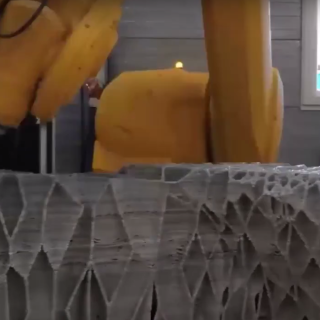A robotic 3D-printed chaise longue that can be transformed into a
bed (and back again). This creation by TU Delft researchers can now be
seen in the Delft Science Centre. The researchers expect that this kind
of transformable material will be used in many more applications in
construction and interior architecture in the future.
Chaise
Concepts such as 3D printing, variable rigidity and transformable structures are still relatively new, but researchers at TU Delft are already working on creating objects that can adapt and change depending on the needs of the user, in a process that you could call 4D. More specifically, researcher Arwin Hidding and his supervisor, associate professor Henriette Bier, have focused on designing an innovative chaise longue. The team from the Robotic Building research group (Faculty of Architecture and the Built Environment) have created a 3D-printed chaise longue that can change from a chair to a bed and back again. The chaise longue changes shape through the pressure of the weight of the user depending on whether the person is lying or sitting.
Form
The project makes use of variable rigidity in order to achieve multifunctionality. The design is based on supporting a person of average build and the shape-change mechanism is activated by the weight pressing against the back of the chair. The transformation is achieved by a combination of variation in material distribution and the use of 'thermoplastic elastomers' (TPEs). When this material exceeds its melting point, it can be made into a different shape without compromising its elasticity. The TPEs enables the form of the chaise longue to be returned to the original firm structure.
If you exert pressure on the back of the chair, it becomes hard once more. The current design and calculations are based on a person of average build, but this can be changed. The chair offers the user exactly what they want at that moment. Whether they want to sit or lie down, all the user has to do is lean against the back to activate the transformation process.
Starting point
The ‘4D-printing’ concept encourages designers to explore new ways of thinking about many objects, including furniture. The chaise longue is intended as a starting point for a broader development. The principles could also be used in interior architecture and in construction processes.
The chair can be seen from 12 to 16 November in the Science Centre in Delft, during the exhibition on adaptive prototypes. The chaise longue also featured in the Dutch Design Week at the end of October. The project was funded by 4TU Bouw. In addition to Delft University of Technology, TU Eindhoven and the École polytechnique fédérale de Lausanne (EPFL) and the companies, 3D Robot Printing BV and Dutch Growth Factory, were involved in the project. The chaise longue was printed in 3D by 3D-RobotPrinting in Rotterdam.
